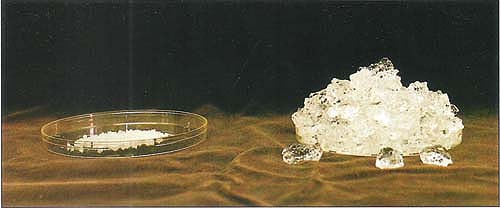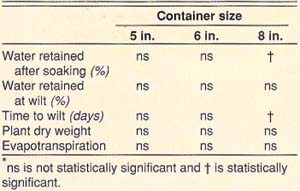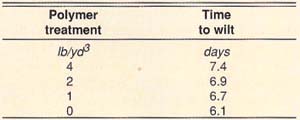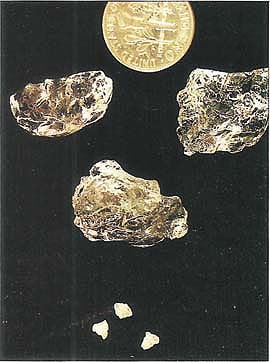All Issues
A greenhouse experiment finds water-sorbing polymers do not conserve water
Publication Information
California Agriculture 46(3):9-10.
Published May 01, 1992
PDF | Citation | Permissions
Abstract
To assess claims that water-sorbing polymers promote water conservation, a greenhouse experiment with container-grown marigolds was conducted to determine the effect of adding the polymers to soil mix. Plant growth and water retention in I- and 3-quart containers were not particularly affected, but in the 6-quart size, maximum water retention was significantly higher for the 4 lb/yd3 polymer treatment than for the other treatments, and the time from watering to wilt progressively increased from 6.1 to 7.4 days for the 0, 1, 2 and 4-lb/yd3 treatments. However, no water conservation occurred because evapotranspiration was not significantly affected by the polymer treatment.
Full text
Dry polymer crystals on the left contrasted with same crystals after 130 ml of water have been added.
As a result of the drought in California, various products have been suggested to promote water conservation, including commercially produced water-sorbing polymers that can absorb hundreds of times their weight in water. The claim is that incorporating these polyacrylamide polymer granules in the soil results in increased retention of large quantities of water that become available for plant growth.
The difference between amounts of water retained by treated and untreated soils depends on soil texture, soil structure and the salinity of both soil and water. Untreated soil media itself is capable of retaining large quantities of water; the greatest increase in water retention by polymer treatment can be expected in media containing large pores.
Promotion of polymers as water conserving received a major boost by one large California water district noted for effectively educating the public and promoting water conservation. The district distributed packets containing a sample of polyacrylamide polymer granules. The packet's label carried the following message:
How to save water without even trying. This package of ‘polyacryla-mides’ can help you save water, and make caring for your plants easier at the same time. The little beads inside attract and hold water up to 10 times longer than soil alone. Simply mix into the soil of a 6-inch potted plant, and water once. You shouldn’t have to water again for 2 to 3 weeks. Using polyacrylamides in all your pots and garden areas can reduce your watering needs by 60% or more! They are available in larger quantities at your nursery.
Greenhouse experiment
An experiment was conducted in the greenhouse on potted plants in three container sizes to check the validity of the claims. The containers were 5 inches in diameter by 5 inches high, 6 inches in diameter by 7 inches high, and 8 inches in diameter by 9 inches high. Approximate volumes of these containers were 1, 3 and 6 quarts. The potting mix consisted of 50% plaster sand, 25% bark shavings and 25% peat moss. Nitrogen, phosphorus, potassium and micronutrients were added to the mix. The potting mix was amended with 0, 1, 2 and 4 pounds of polymer per cubic yard of mix. Suppliers of the polymer recommend an application rate of 2 pounds per cubic yard of soil mix. (Although various polymers are marketed under different tradenames, they are similar in chemical nature and would have comparable effects.)
Marigold seeds were initially germinated in pure silica sand and nutrient solution. After about 2 weeks, the 4-inch-high plants were transplanted into the experiment's containers. The numbers of plants per container were one, two and four in the 1-, 3- and 6-quart containers, respectively. Treatments were run in triplicate in a randomized block design.
The containers, irrigated regularly to maintain plant turgor, were periodically weighed to compute evapotranspiration and to determine water loss and, subsequently, how much water to apply without leakage from the container bottom. The plants were allowed to grow for 3 weeks, after which excess water was applied to each container; considerable drainage resulted.
After drainage had stopped, each container was weighed to determine the amount of retained water. The measurement allowed computing the difference in water retained in treated and untreated soil mix. No more watering was done and the plants were allowed to go to the wilting stage. The number of hours between the last watering and when the plants were judged permanently wilted was recorded. When the shoots were wilted, they were cut, dried at 150°F (65°C) and weighed. The water content of the soil mix was also determined at the wilting stage.
TABLE 1. Statistical significance (5% probability level) of polymer treatment effects in various container sizes*
Results
Results are summarized in table 1. Statistically significant polymer treatment effects were only observed in the 8-inch diameter container. In these containers, the polymer treatment significantly affected the amount of water retained in the soil mix after soaking and the number of days until the plants wilted. The polymer treatment did not affect the soil water content at the wilting time, indicating that water retained by the polymer was readily available to the plant. Plant growth and evapotranspiration were not significantly affected by polymer treatment in any containers.
The soil amended with the 4-lb/yd3 polymer treatment retained significantly more water than the control (table 2). The two lower polymer treatments did not retain significantly more water than the control. The number of days to wilting progressively increased with increasing polymer treatment (table 3) and the trend was statistically significant. Although the polymer treatment did increase the time to wilting, the increase was only about 1 day out of a week, and certainly would not allow a 6-inch potted plant to go 2 to 3 weeks without water, as claimed on the label of the water district's sample package.
Conclusions
Concerning the utility of water-sorbing polymers in container-grown plants, polymers can sorb and hold water, but the quantity of extra water held in the container depends on the nature of the porous media and the size of the container. The mix used in our experiment was porous and typical of the medium used in containers. Water absorbed by the polymer was available for plant use and may extend the time between waterings. Note, however, that the extended time was not great, about 1 day out of 7.
Use of polymers does not conserve water. Water loss through evapotranspiration was the same for all treatments. Extending the time between irrigations does not conserve water because more water has to be applied at the time of irrigation to recharge the container to full water-holding capacity. In this experiment, the polymer treatments had no effect on plant growth.
Similar principles are involved in using polymers in the landscape. Potential benefits to be achieved depend on soil texture. Coarse-textured soils with large pores tend to retain less water than finer-textured soils. Thus, the amount of water that may be retained by incorporating a polymer would be greater in coarse-textured soils than in fine-textured soils.
Use of polymers should be coordinated with irrigation scheduling. If the polymer allows greater water retention in coarse-textured soils, irrigations can be applied less frequently but in greater quantity when applied. In a properly scheduled irrigation scheme, the total amount of water annually applied will be about the same with and without polymers. Only timing and amount are altered. This result is based on the fact that the polymer does not alter evapotranspiration. Water application must equal evapotranspiration, and the only factor that is altered is the storage capacity of the soil between irrigations. Thus, use of polymers is not a water conservation practice with proper irrigation management.
As is the case with almost all products, polymers can be effectively used to accomplish certain goals, such as increasing the water-holding capacity of some soils. They are not beneficial in all cases. Potential users must clearly identify what they hope to accomplish and evaluate whether the polymer will indeed accomplish that goal. Also, they must consider whether there are alternatives to accomplishing the same goal and then compare the relative costs.









